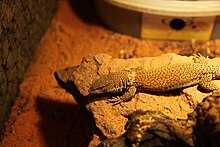Loading AI tools
Species of lizard From Wikipedia, the free encyclopedia
Kings' monitor (Varanus kingorum), also known commonly as Kings' goanna, Kings' rock monitor, and the pygmy rock monitor, is a small species of monitor lizard in the family Varanidae. The species is native to Australia.
| Kings' monitor | |
|---|---|
 | |
| Scientific classification | |
| Domain: | Eukaryota |
| Kingdom: | Animalia |
| Phylum: | Chordata |
| Class: | Reptilia |
| Order: | Squamata |
| Family: | Varanidae |
| Genus: | Varanus |
| Subgenus: | Odatria |
| Species: | V. kingorum |
| Binomial name | |
| Varanus kingorum | |
V. kingorum is endemic to the northwestern part of the Northern Territory, and the adjacent northeastern part of Western Australia.
The original description of V. kingorum as a species new to science was published in 1980, the result of a revision of Western and Central Australian varanid taxa.[3]
Kings' monitor belongs to the subgenus Odatria[4] along with the peacock monitor and the Pilbara monitor. Comparatively little is known about this species.[5]
The holotype was collected beneath rocks in 1978 at Timber Creek in the Northern Territory by Max King.
The specific name, kingorum (genitive plural), is in honour of Canadian-born Australian ecologist Richard Dennis King (1942–2002) and Australian geneticist Max King (born 1946),[6] honouring their contributions to the understanding of Australia varanids.[3]
Kings' goanna inhabits rocky outcrops of the Kimberley region and adjacent areas.[7] It is usually found in areas with rock exfoliations or slopes with open bushland and shrubs, where boulders and outcrops provide its required microhabitat.[8] V. kingorum is also found in grasslands.[9]
V. kingorum is one of the smallest species of its genus, reaching a total length (including tail) of up to 40 cm (16 in).[7] It is reddish brown in colour with a black reticulum in the juvenile that breaks down with age to form dark flecks.[5] Small blackish spots appear at most parts of the dark upper body, and at the throat and near the vent against the creamy colour of the underparts.[3]
Kings' monitor retreats into holes, rock fissures, and small crevices when it is approached, being extremely shy.[8]
This species has a long tail that is sometimes used to prod prey out of tight, inaccessible crevices. Such is a behaviour demonstrated by both adults and hatchlings alike, and as such is likely instinctual rather than learned.[10]
V. kingorum is oviparous. The incubation period of the eggs ranges from 89 to 126 days at a temperature of 29 +/- 2 °C.[10]
V. kingorum appears to feed exclusively on insects, including locusts, termites, and insect eggs.[5]
Seamless Wikipedia browsing. On steroids.
Every time you click a link to Wikipedia, Wiktionary or Wikiquote in your browser's search results, it will show the modern Wikiwand interface.
Wikiwand extension is a five stars, simple, with minimum permission required to keep your browsing private, safe and transparent.